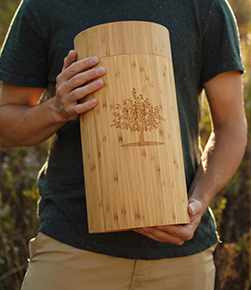| TOOLBOX TIPS |
 |
While volunteering in a nursing home several years ago, I found a tiny, homemade pamphlet someone had left. It comprised a few poems, and I thought I would like to have something like that in my doula bag.
|
|
I purchased a journal and started pasting a few poems that I loved into its blank pages. Next, I looked for more, focusing on poetry that was about floating, water, nature, love, and end-of-life. Today my book contains a lot of Mary Oliver; I’m a fan, and her words seem to be beautifully compatible for this work. Additionally, I have gathered poetry from dozens of different writers, including John O’Donohue, Robert Frost, Ralph Waldo Emerson, Lord Byron, Stephen Levine, Ram Dass, a splattering of Rumi, and even some song lyrics. Near the back of my book I have several Bible verses, Christian prayers, and a rosary prayer I inserted upon a client’s request, along with prayers from different religions. Obviously, I only use the religious readings if I know the patient to be practicing a specific faith.
I still continue to add to the few remaining blank pages and find myself listening and reading with awareness for additional writings to include. I don’t always use my book, but in my experiences reading from it during many vigils, I recognize signs that the words are calming to a person in transition.
—Jeannie Palermo
|
|
| SHARING SOURCES |
| The Living Urn |
|
As more people turn to cremation in the United States, the options for urns and sustainable containers has grown. The Cremation Association of North America reports a 7.5% increase in cremation in the past five years. In 2020, 56.1% of individuals who died in the United States were cremated. In Canada, the number was even higher, with 73.1% of all deceased being cremated. These growing numbers, coupled with a growing awareness of the environmental impact of burials, has led to new product developments, from eco-caskets to shrouds to biodegradable urns.
|

|
|
One of the leaders in eco-urns is The Living Urn. The Denver-based company’s unique, patented urn provides the nutrients necessary for establishing a memorial tree from the deceased’s ashes.
|
|
|

|
|
|
ASK INELDA
|
 |
|
I have become friendly with a neighbor who is in his eighties and thriving. When I told him about the work I’m pursuing as a doula, he became very interested in examining his own views on death. After growing in relationship, he asked me to be his doula when the time comes. Since he has no diagnosis and is not actively dying, at what point is it appropriate for me to start working with him? —B.S.
|
|
Trainer Garrett Ellis: The beautiful thing about the end-of-life doula model of care, and INELDA’s three-phase model in particular, is that a doula can begin implementing it with a client at any time. It lends itself to being most effective when started early and with what we call “Summing Up and Planning,” or phase one.
You have a beautiful opportunity to begin working with your neighbor earlier than most. A diagnosis is not necessary to begin working with him as his doula; all that is needed is a relationship and an open heart. When both you and your client are ready and have decided the time is right for you to begin, consider helping him with things such as legacy work, exploring his life’s meaning, advance directives, decreasing death anxiety, and planning for his active dying phase. Seeing as you have a good amount of time to build a relationship with your neighbor, you are uniquely equipped to offer him a richer experience and a deeper connection before he engages in his last days.
|
Please submit questions to [email protected]
|
|
|
| Self-Care Prescription |
|
Let us honor balance: Quality caregiving involves a lot of energy. Providing emotional support, facilitating communication, organizing for clients, and processing one’s own emotions all demand time and focus. In our heartfelt desire to care and serve, we run the risk of falling out of balance.
There was a period when I was overworked as a birth doula and spun into burnout. As I prioritized clients’ needs, I found myself sometimes turning away referrals with more irritation and less gratitude, and it was visibly taking a toll on my mind and body. My inability to say “no” with grace was born of three main things: my compassion for others, patterns ingrained by my socialization process, and a scarcity mentality.
Perhaps we can all intellectually agree that a balanced workload enables us to not only stay healthy, but also to serve our communities better. What’s left is the not-so-small problem of taking that knowledge and applying it to our lives.
Let us ask ourselves:
- Can we plan how many hours we generally want to work, or how many clients we can handle at a time?
- Can we honor the rhythms of life and course-correct when things change?
- Are there aspects of life we must hold sacred, and can we set effective boundaries that protect them?
- Do we need to unlearn unhealthy social messaging about productivity and integrate sound understandings of how to best live life?
- In committing to our balance, do we need to secure support from those close to us?
- Can we delegate domestic tasks, or build networks of colleagues to refer to, or ask friends to invite us out so we have ample play in our lives?
- Might we give ourselves the same love and respect we’d give to any other person, in thought, word, and deed?
— Lara Stewart-Panko
|
 |
|

